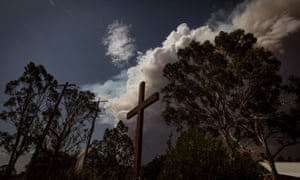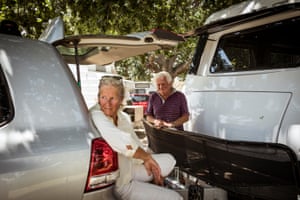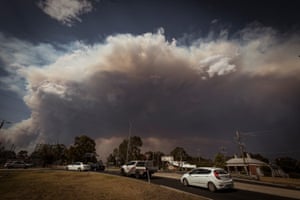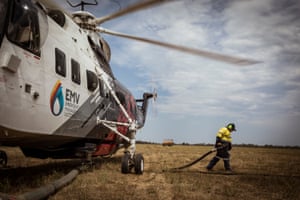
Many visitors and residents left homes and campsites in East
Gippsland ahead of a terrifying fire day, but others ignored warnings
and stayed behind
- Follow Tuesday’s Australia fires live blog: multiple properties lost in Victoria as NSW faces fresh bushfires threat - latest updates
Marilyn
Withers packed a sun tent and a camping chair when she fled the
bushfire threatening to engulf her home. But when she arrived at Howitt
Park, an area outside the immediate danger zone, the blistering
temperatures made it too hot to sit outside and the hairdryer wind kept
blowing down the tent.
“I’ve just got the air conditioner on to try and cool the dogs down a bit,” Withers, 77 and recently widowed, said from the driver’s seat of her 4WD. The passenger side was taken up by a bed cover and bowls filled with water for the dogs, Majic and Puku, who were panting under wet towels. The back seat contained photos of her late husband and the home they built together at Nicholson 15km away – a home that her son had stayed behind to try to save from the inferno being blown towards it.
“I did not want to leave the house,” Withers says. “[My son] knows I am capable but I think he also knows that I am a bit erratic and emotional at the moment. It’s really hard – I didn’t think it would happen like this.”
Nicholson is just inside the area earmarked by the Victorian emergency management commissioner, Andrew Crisp, on Sunday as at very high risk from four out-of-control bushfires burning steadily toward the coastal holiday towns of Lakes Entrance and Orbost.

“I’ve just got the air conditioner on to try and cool the dogs down a bit,” Withers, 77 and recently widowed, said from the driver’s seat of her 4WD. The passenger side was taken up by a bed cover and bowls filled with water for the dogs, Majic and Puku, who were panting under wet towels. The back seat contained photos of her late husband and the home they built together at Nicholson 15km away – a home that her son had stayed behind to try to save from the inferno being blown towards it.
“I did not want to leave the house,” Withers says. “[My son] knows I am capable but I think he also knows that I am a bit erratic and emotional at the moment. It’s really hard – I didn’t think it would happen like this.”
Nicholson is just inside the area earmarked by the Victorian emergency management commissioner, Andrew Crisp, on Sunday as at very high risk from four out-of-control bushfires burning steadily toward the coastal holiday towns of Lakes Entrance and Orbost.

Many locals viewed the order to leave East Gippsland as a directive for tourists. Some tourists also ignored the warning, or did not know about it.
By 3pm on Monday, the Princes Highway to Lakes Entrance had been cut off, trapping any tourists who left it too late on the wrong side. The Great Alpine Road has been closed by fire for weeks.
Ben Rankin, who is managing the fire for the Victorian Department of Environment, Land, Water and Planning, said holidaymakers would probably be safe if they stayed in Lakes Entrance proper, but they would not be able to get out.
Craig Anderson did not want to take that risk. He and his family, along with his friend Brendan Gaffey and his family, left their camp ground at Kalimna, just outside Lakes Entrance, on Monday morning. “If the highway is closed we would rather be on this side of it.”
Irene McCarthy and her partner, Hugh Hunter, live at Metung, west of Lakes Entrance. They decided to take the caravan to Bairnsdale after firefighters at a community meeting on Monday morning told them they would not attempt to protect the Metung yacht club, which had been identified as the safe place to which they could flee.

The couple moved to Metung from the UK 12 years ago and “most of the time we absolutely love it”, Hunter says. “Last night was not one of those ‘love it’ nights.”
Plumes of smoke 12km tall
The wind blows hot through East Gippsland, the temperatures in the low 40s, 16C above average. It is what distinguishes a really terrible fire day from merely a hot day in summer – a wind that heats rather than cools the sweat on your back, as though it has blown directly from the fire itself.The heat began to build at East Gippsland at 10am, the wind from midday.

By 4pm, the plume of smoke had quadrupled in size and loomed over the town, growing taller and blacker by the minute and burning toward Lakes Entrance, just east of Bairnsdale.
At a pull-off spot on the way out of town, residents park their cars and take photos of the smoke. “That’s not a thunderstorm,” says one woman. “That’s a bushfire.”
Another local is more succinct. “Fuck,” he says.
Thunderstorms are coming too – a warning of gusty winds and dry lightning, which will start more bushfires, was issued mid-afternoon.
The wind change is not forecast to hit until midnight. It will bring cool weather as well as gusty winds that will swing the eastern flank of the fire into a new front many hundreds of kilometres long.
Thirteen kilometres out of Bairnsdale is a corrugated iron demountable, which serves as the base for the department’s aerial firefighting activities. Water-bombing helicopters and planes land every hour to be refuelled before heading back to the fire ground.

The drivers of fuel tankers sit and wait, eating Zooper Doopers to survive the heat.
On a day like this, aircraft are the only tool available to quell the fire front. Thirteen strike teams – groups of five trucks filled with firefighters from the department or the Country Fire Authority – have been deployed to protect lives and towns, but it is too dangerous for them to approach the fire itself.
For residents fighting to defend their homes against the approaching flames, an approaching helicopter sounds like salvation.
Isolated villages such as Goongerah, which is directly in the path of the Barmouth-Spur fire, were told to evacuate on Saturday. Some residents, like the well-known sustainability pioneer Jill Redwood, have remained.
“We have been told there won’t be any emergency services in Goongerah, there won’t be any strike teams here,” Redwood told Guardian Australia early on Monday. “It is too dangerous. And in the worst-case scenario we could be cut off for weeks.”
Redwood has a fire bunker – a “glorified wombat hole” – and believes her home to be defensible.
“It’s probably going to be a bad one, maybe worse than I have experienced before,” she says. “I might end up a stick of charcoal, but I will do my best not to.”
No comments:
Post a Comment